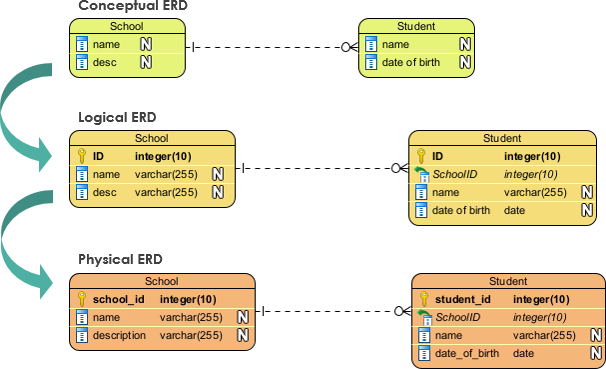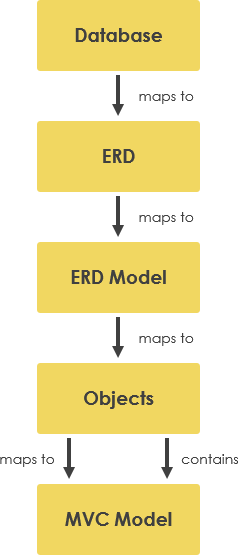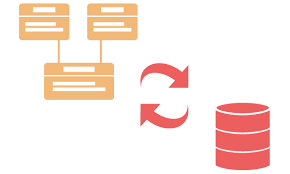Introduction to Data Modeling with Visual Paradigm: ERD Diagramming, Code Generation, and Reverse Engineering
Data Modeling and Object Modeling: A Synergistic Relationship
Data modeling is the process of creating a visual representation of data and its relationships. It helps to understand the data and its structure, which is crucial for developing software applications, databases, and other data-related projects.
Object-oriented (OO) system development is a software development methodology that emphasizes the use of objects and classes to represent real-world entities and their relationships. Object modeling is a key aspect of OO system development. It involves creating a model of the system using objects, classes, and their relationships.

- Data modeling and object modeling are related in that they both involve creating models to represent entities and their relationships. In an OO system, objects and classes are used to represent real-world entities, and their relationships are defined using associations, aggregations, and compositions.
- Data modeling, on the other hand, involves creating a model of the data and its relationships. The data model can then be used to design a database schema, which can be used to store the data in a structured manner. In an OO system, the data model can be used to create the object model, and the object model can be used to generate the database schema.
- Data modeling is essential for designing and developing software applications that rely on data. It is closely related to object modeling in OO system development, as both involve creating models to represent entities and their relationships. By using data modeling and object modeling together, developers can create robust and scalable software applications that meet the needs of their users.
The Role of ERD and Class Diagrams in Data Persistence and Object-Oriented Design
Entity-relationship diagrams (ERDs) and class diagrams are both essential tools for modeling data and systems in software development. ERDs are primarily used to model the data persistence layer of a software system, while class diagrams are used to model the object-oriented programming (OOP) layer.
ERDs mirror the database persistence reality by representing the tables, columns, and relationships of a database in a graphical format. ERDs provide a visual representation of the data structure, which can be used to design and optimize the database schema. ERDs are an important tool for database administrators, data analysts, and developers who work with data-intensive applications.
On the other hand, OOP systems are typically designed using the Model-View-Controller (MVC) architecture, which separates the system into three distinct layers: the model, the view, and the controller. The model layer is responsible for managing the data and its relationships, while the view layer is responsible for displaying the data to the user. The controller layer acts as the intermediary between the model and the view, controlling the flow of data and interactions between the two.
In an OOP system, the class diagram is used to integrate between the data and the persistent data (ERD), as well as to represent all three layers of the MVC architecture. The class diagram provides a visual representation of the objects and classes in the system, their attributes and methods, and their relationships with each other. The class diagram acts as the model layer in the MVC architecture, managing the data and its relationships.
The class diagram also interacts with the user through the view layer, which is controlled by the logic in the controller layer. The controller layer is responsible for managing user interactions and updating the model layer accordingly. The class diagram plays a critical role in integrating the data and the user interface in an OOP system, and it is essential for developing scalable and maintainable software applications.
In conclusion, ERDs mirror the database persistence reality, while class diagrams are used to model the OOP layer and integrate between the data and the persistent data. The class diagram plays a critical role in the MVC architecture, managing the data and interactions with the user interface. By using both ERDs and class diagrams, developers can create robust and scalable software applications that meet the needs of their users.

Data Modeling with Visual Paradigm
Data modeling is the process of creating a visual representation of data and its relationships. It helps to understand the data and its structure, which is crucial for developing software applications, databases, and other data-related projects. Visual Paradigm is a powerful tool that can be used for data modeling. In this article, we will introduce some of the key features of Visual Paradigm for data modeling.
- ERD DiagrammingEntity-Relationship Diagrams (ERD) are the foundation of data modeling. ERD diagrams represent entities, attributes, and relationships in a graphical way. Visual Paradigm provides a user-friendly interface for creating ERD diagrams. It allows users to drag-and-drop entities, attributes, and relationships onto the diagram canvas. Users can also customize the appearance of the diagram by changing the color, font, and size of the elements.
- Hibernate code generate from class and to hibernate automaticallyHibernate is a popular Java-based ORM (Object-Relational Mapping) framework. It is used to map Java objects to database tables. Visual Paradigm provides a feature to generate Hibernate code from Java classes automatically. This feature saves a lot of time and effort as users don’t have to write the Hibernate code manually. Visual Paradigm also provides a feature to convert Hibernate code to Java classes.
- Round-trip code generation from Class diagram to database schemaRound-trip code generation is a useful feature in Visual Paradigm that allows users to generate code from a Class diagram and synchronize it with the database schema. This feature ensures that the code and database schema remain consistent with each other. Users can also make changes to the Class diagram and synchronize them with the database schema. This feature saves a lot of time and effort as users don’t have to manually update the code or database schema.
- Reverse Database to Schema to Class diagramVisual Paradigm provides a feature to reverse engineer a database schema into a Class diagram. This feature allows users to create a Class diagram based on an existing database schema. Users can also make changes to the Class diagram and synchronize it with the database schema. This feature is useful when working with an existing database and want to create a Class diagram based on it.

Why Visual Paradigm for Data Modeling
Visual Paradigm (VP) is an excellent tool for data modeling, and I would highly recommend it for any organization looking to improve their data modeling capabilities. The tool is intuitive, user-friendly, and allows for seamless integration between ERD and class diagramming. It also offers a range of features such as automatic Hibernate code generation from class, round-trip code generation from class diagram to database schema, and reverse database to schema to class diagram, which saves time and effort during the development process. With VP, users can easily visualize their data structures and relationships, ensuring that their data models accurately reflect the real-world business processes they are designed to support. Overall, VP is an excellent tool for data modeling, and its wide range of features make it a top choice for any organization looking to improve their data modeling capabilities.
In conclusion, Visual Paradigm is a powerful tool for data modeling. It provides a user-friendly interface for creating ERD diagrams, generating Hibernate code from Java classes, round-trip code generation, and reverse engineering a database schema into a Class diagram. These features save a lot of time and effort and ensure that the code and database schema remain consistent with each other. If you are working on a data-related project, Visual Paradigm is definitely worth considering.

